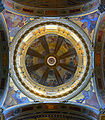
Sant'Ambrogio e Carlo al Corso is a basilica church in Rome, Italy, facing onto the central part of the Via del Corso. The apse of the church faces across the street, the Mausoleum of Augustus on Via di Ripetta.

Roch, also called Rock in English, was a Majorcan Catholic confessor whose death is commemorated on 16 August and 9 September in Italy; he was especially invoked against the plague. He has the designation of Rollox in Glasgow, Scotland, said to be a corruption of Roch's Loch, which referred to a small loch once near a chapel dedicated to Roch in 1506.

San Pietro in Montorio is a church in Rome, Italy, which includes in its courtyard the Tempietto, a small commemorative martyrium ('martyry') built by Donato Bramante.

Giuseppe Valadier was an Italian architect and designer, urban planner and archaeologist and a chief exponent of Neoclassicism in Italy.

Sebastiano Ricci was an Italian painter of the late Baroque school of Venice. About the same age as Piazzetta, and an elder contemporary of Tiepolo, he represents a late version of the vigorous and luminous Cortonesque style of grand manner fresco painting.

The Confraternities of the Cord are pious associations of Christians, the members of which wear a cord, girdle or cincture in honour of a Catholic saint or Angel whom they wish to honour and emulate.

The Basilica of Saint Sylvester the First, also known as, is a Roman Catholic minor basilica and titular church in Rome dedicated to Pope Sylvester I. It is located on the Piazza San Silvestro, at the corner of Via del Gambero and the Via della Mercede, and stands adjacent to the central Post Office.
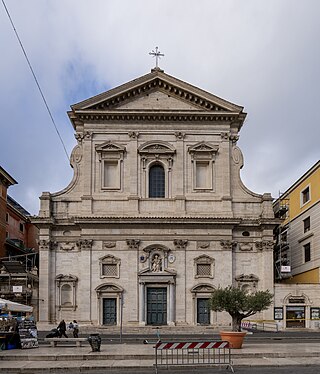
The Church of Santa Maria del Carmelo in Traspontina is a Roman Catholic titular church in Rome, run by the Carmelites. The bridge referred to is the Ponte Sant'Angelo. The church is on the Via della Conciliazione, the primary road of the Roman Rione of Borgo.
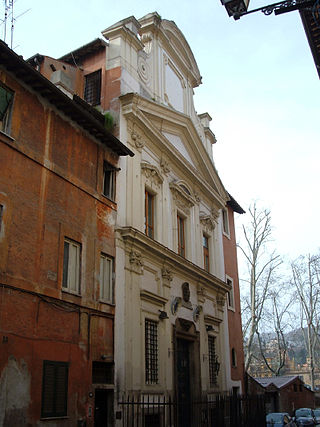
The Oratorio del Gonfalone or Oratory of the Banner is a building in Central Rome which once housed a Catholic fraternity. Since about 1960 it has served as a concert venue for the Roman Polyphonic Choir.
Giuseppe Antonio Caccioli was an Italian painter of the Baroque period.
The Archconfraternity of the Most Precious Blood was founded by Francesco Albertini, canon of the Basilica di San Nicola in Carcere, Rome, in 1808.

Confraternities of penitents are Christian religious congregations, with statutes prescribing various penitential works; they are especially popular in the Catholic Church. Members of the confraternities of penitents practice mortification of the flesh through fasting, the use of the discipline, the wearing of a hair shirt, among other instruments of penance, etc.

Our Lady of Providence or Our Lady of Divine Providence is a title of Mary. Her feast day is celebrated on 19 November.

The Chiesa della Santissima Trinità dei Pellegrini is a Roman Catholic church located on Via dei Pettinari #36 In the rione of Regola of central Rome, Italy. It stands a block away from the Palazzo Spada on Via Capo di Ferro, while a few blocks away on the Via dei Pettinari stands the Ponte Sisto.

Santa Lucia del Gonfalone is a church in the diocese of Rome, Italy. It is located on Via dei Banchi Vecchi just one block south of Corso Vittorio Emanuele. The former site of the Archconfraternity of the Gonfalone, the Claretian Missionaries have their provincial headquarters here. The church was made a cardinalate deaconry by Pope John Paul II on 21 October 2003.
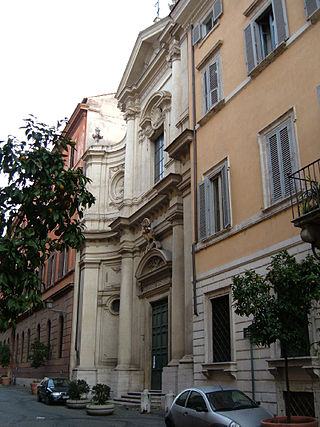
Santa Caterina da Siena is a church in Rome dedicated to Catherine of Siena. It is sited on via Giulia in the Regola district.
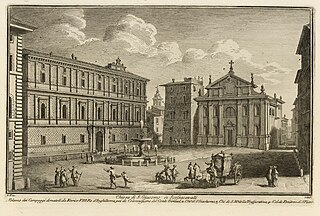
San Giacomo Scossacavalli was a church in Rome important for historical and artistic reasons. The church, facing the Piazza Scossacavalli, was built during the early Middle Ages and since the early 16th century hosted a confraternity which commissioned Renaissance architect Antonio da Sangallo the Younger to build a new shrine. This was richly decorated with frescoes, painted by mannerist artist Giovanni Battista Ricci and his students. The church was demolished in 1937, when Via della Conciliazione was built and the piazza and central part of the Borgo rione were demolished. Many decorative elements still exist, since they were preserved from demolition.

Our Lady of Consolation or Mary, Comforter of the Afflicted is a title of the Blessed Virgin Mary venerated in the Roman Catholic Church.

San Michele Arcangelo ai Corridori di Borgo was a church in Rome dedicated to St. Michael, the Archangel, important for historical and artistic reasons.

The Hospital of San Rocco at Porto di Ripetta, also known as Ospedale delle Celate, was a hospital in Rome (Italy) built by the Archconfraternity of hosts and boatmen, which also managed the church of San Rocco all'Augusteo. It was rebuilt on the same site at the end of the 18th century]and served as a hospital until 1892. The building was demolished in the 1930s to make room for the current Piazza Augusto Imperatore.






